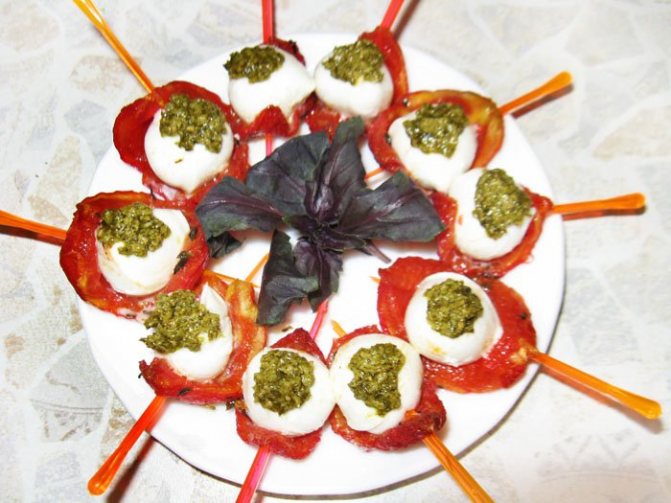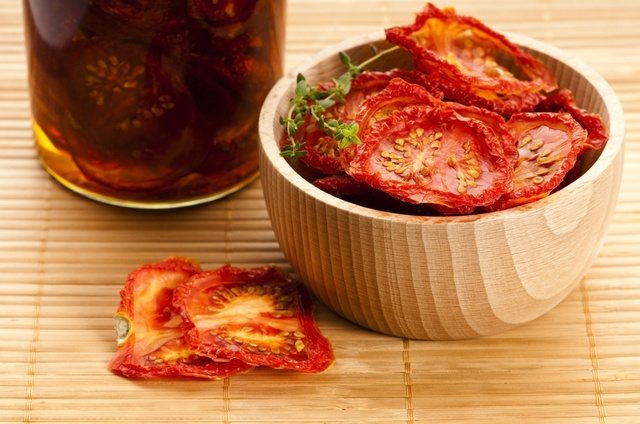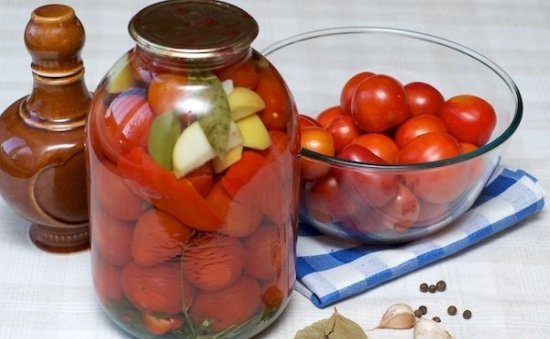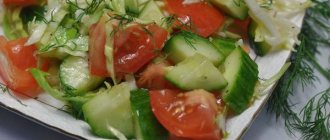Homemade sun-dried tomatoes - what are the benefits and harms depending on the type of preservative
Despite the availability of packaged dried tomatoes from southern Europe in stores, many gourmets prefer to cook them at home. According to classical technology, olive oil is used as a preservative; by the way, this also applies to factory-made products. We’ll discuss how justified this is below, but for now let’s evaluate the filling options and which oil is best avoided:
- Olive oil - everyone who is attracted by aromatic sun-dried tomatoes in oil and their benefits and harms tries to consume their favorite product with this particular filling. It must be said that this preference is quite justified. The main component here is oleic acid omega-9, which has a beneficial effect on the human circulatory system. This is despite the presence of a negative 9:1 ratio of unsaturated omega-6 to omega-3 acids.
- Soybean oil – has optimal proportions of ω-6 and ω-3 fatty acids (4.6:1), which helps reduce “bad” cholesterol in the body. In addition, the product contains alpha-lipoic acid (2.12%), which supports metabolism and is an antioxidant.
- Rapeseed oil is the best option for those who decide to dry tomatoes at home or buy finished products in a store. The ratio of omega-6 to omega-3 is 2:1, which is almost ideal. An excess of ω-6 acid leads to decreased immunity and the development of inflammatory processes in the body. In the old days, the product contained a lot of erucic acid, which negatively affected the heart and liver. However, breeders have managed to produce seeds that do not contain this harmful substance.
Important! Avoid sunflower oil, which has an omega-6 to omega-3 ratio of 136:1! These figures are no less dangerous for fillings made from corn (59:1) and grape seeds (130:1).
Is filling necessary?
If you love sun-dried tomatoes and the benefits and harms of the snack are no less interesting than the price, then you should listen to the opinion of some culinary specialists. They claim that there is no need to use oil as a filling - it makes the dried product tough. This method of preparation was used in the good old days by the founders of pomodori secchi - the Italians. However, not even everyone in Italy knows about this.
According to true connoisseurs, the filling began to be used as a preservative when the product began to be prepared on an industrial scale. But how then to consume “drying”?
Tomatoes are dehydrated, so they are prepared before consumption, that is, they are replenished with water. There are two ways to accomplish this task:
- Soak the portion overnight in cold water. The method helps to free the product from excess salt and makes the pulp juicy with a rich taste.
- Boil the required amount of water with a small addition of vinegar and add dried tomatoes to it. Cook for 1-2 minutes. The method is quick, but the quality of the product suffers - acetic acid negates all the sweetness of the summer vegetable. The pulp will be more compact than in the first method, but more chewy.
After such simple procedures, the workpiece is dried and then used to prepare dishes from dried tomatoes or sauces.
What to do when the dryers are already filled with oil? You need to carefully drain it, put the tomatoes in a container with cold water - the oil is lighter than water, it will float, and the product will soak. Then take out the tomatoes and dry them, heat the old filling with spices and pour the workpiece over a new one.
Calorie content Sun-dried tomatoes. Chemical composition and nutritional value.
Nutritional value and chemical composition of “Sun-dried tomatoes”.
The table shows the nutritional content (calories, proteins, fats, carbohydrates, vitamins and minerals) per 100 grams of edible portion.
| Nutrient | Quantity | Norm** | % of the norm in 100 g | % of the norm in 100 kcal | 100% normal |
| Calorie content | 100 kcal | 1684 kcal | 5.9% | 5.9% | 1684 g |
| Squirrels | 0.9 g | 76 g | 1.2% | 1.2% | 8444 g |
| Fats | 9.4 g | 56 g | 16.8% | 16.8% | 596 g |
| Carbohydrates | 3 g | 219 g | 1.4% | 1.4% | 7300 g |
The energy value of sun-dried tomatoes is 100 kcal.
Primary Source: Created in the application by the user. Read more.
** This table shows the average levels of vitamins and minerals for an adult. If you want to know the norms taking into account your gender, age and other factors, then use the “My Healthy Diet” application.
What are the benefits and harms of your favorite sun-dried tomatoes in oil: main points
Their uniqueness primarily lies in the large number of minerals, vitamins and microelements. Not many vegetables have this quality.
Compound
Drying allows you to preserve almost all the beneficial substances of tomatoes. With their reasonable consumption, metabolic processes in the human body are noticeably improved. To compare and evaluate the benefits and harms of real sun-dried tomatoes, just look at their set of elements:
- 100 grams of product contains 28% of the daily value of fiber, 27% of iron and 39% of potassium.
- One hundred grams of dried vegetables covers the body’s daily need for vitamin A by 16%, C by 23%, niacin by 31%, thiamine and riboflavin by 23%.
- Dried tomatoes contain B vitamins: B6, B9 and B3, as well as vitamin K.
- Tomato delicacy is a source of saturated fatty acids, sodium, calcium, magnesium, zinc, copper, phosphorus, selenium and manganese.
Contraindications
Even if there are benefits from eating sun-dried tomatoes, they are not always beneficial. Previously, it was believed that due to oxalic acid, tomato products were harmful for joint diseases, osteoporosis and the presence of stones in the gall bladder and ducts. But it turned out that there is not so much of it, for example, in beets there is 8 times more acid, and in potatoes it is even 10 times more. As a result, lovers of this delicacy should adhere to certain standards:
- If you want to experience all the benefits and harms of delicious sun-dried tomatoes in oil, you need to consume them in moderation. If you are predisposed to food allergies, it is better to avoid the dish altogether.
- Although there is little oxalic acid in the composition of “dried foods,” it is better for patients with gout and people with kidney problems to exclude tomato delicacies from the menu. In acute forms of illness, it can negatively affect the patient's condition.
- People suffering from cholelithiasis should not eat dried vegetables, because tomatoes are a strong cholagogue, and stones may begin to pass out. It is unknown how this will end, perhaps blockage of the bile ducts.
How does a person benefit from sun-dried tomatoes in oil: the main advantages
Lycopene, a substance that reduces oxidative processes in the body’s cells, deserves a separate discussion. Simply put, it slows down aging and prevents cell death. Its antioxidant capacity is 100 times greater than that of vitamin E. This is important because lycopene is not produced by our body, and tomatoes are almost its only source.
All useful substances are preserved, because there is no heating above 40°C during drying, which means that in addition to the aromatic taste, we also get a lot of positive aspects:
- The product improves the condition of the nervous system. It contains serotonin, an excellent antidepressant. Regular consumption of the dish helps improve memory and brain function.
- Dried tomatoes retain full potassium, which is needed to normalize heart function. This microelement also helps remove excess moisture from the body, thereby preventing swelling.
- Tomato “drying” reduces the likelihood of blood clots in blood vessels, which is important for those who suffer from hypertension.
- Low-calorie sun-dried tomatoes in oil and the benefits of consuming them are very noticeable for people who are planning to lose weight. One hundred grams of the product contains only 23 kcal.
- With regular consumption, the product can enhance potency, which is important for men. In addition, microelements help fight gastrointestinal problems.
Calorie content Sun-dried tomatoes. Chemical composition and nutritional value.
Nutritional value and chemical composition of “Sun-dried tomatoes”.
The table shows the nutritional content (calories, proteins, fats, carbohydrates, vitamins and minerals) per 100 grams of edible portion.
| Nutrient | Quantity | Norm** | % of the norm in 100 g | % of the norm in 100 kcal | 100% normal |
| Calorie content | 258 kcal | 1684 kcal | 15.3% | 5.9% | 653 g |
| Squirrels | 14.1 g | 76 g | 18.6% | 7.2% | 539 g |
| Fats | 3 g | 56 g | 5.4% | 2.1% | 1867 |
| Carbohydrates | 43.5 g | 219 g | 19.9% | 7.7% | 503 g |
The energy value of sun-dried tomatoes is 258 kcal.
Primary Source: Created in the application by the user. Read more.
** This table shows the average levels of vitamins and minerals for an adult. If you want to know the norms taking into account your gender, age and other factors, then use the “My Healthy Diet” application.
Summary
Dried tomatoes not only have a rich and appetizing taste, but also a wide range of vitamins and microelements. This helps prevent problems with vision and the cardiovascular system. The product is a powerful antidepressant and is perfect for many diets.
At the same time, it cannot do without negative aspects, of which there are not so many, but they exist. The main thing is to observe moderation and not overuse the product. People suffering from cholelithiasis, gout and food allergies should limit their consumption first of all.
Anna Sergeyevna
ID); // Attachment ID $image_attributes = wp_get_attachment_image_src( $attachment_id, 'full' );// returned array path and thumbnail dimensions $alt = get_post_meta($attachment_id, '_wp_attachment_image_alt', true); ?>
Tags: Drying, Health, Vegetable salads
« Previous entry
Tomatoes: benefits and harm to the health of the body
With the arrival of the summer months, fresh vegetables appear in every market. And one of the most popular, without which it is simply impossible to imagine an everyday table, is, of course, tomatoes. The benefits and harms to the body of these red, yellow, orange and green fruits are not known to everyone, despite their prevalence. How do tomatoes affect us?
Tomatoes during pregnancy
Many expectant mothers often wonder whether tomatoes can be eaten during pregnancy. Their benefits and harms for a woman’s body and her baby have been studied quite well, so answering this question is not difficult.
Due to the high content of folic acid in tomatoes, an expectant mother, by regularly eating them, can protect her child from defects in the nervous system. In addition, this same acid is an excellent remedy for depression, as it prevents excessive accumulation of homocysteine in the body. It is its excess that disrupts the production of hormones that regulate mood, appetite and sleep - dopamine and serotonin.
It is also known that any dishes prepared from tomatoes perfectly activate lactation in nursing mothers, and also increase the level of lycopene concentration in breast milk.
Thus, tomatoes are very beneficial for both the woman and her baby. However, this will only happen if the mother does not have any chronic diseases or individual intolerance to the vegetable.
Red, yellow and green tomatoes are an important component of a healthy diet, because their regular consumption significantly reduces the risk of developing most known diseases. But, whatever the undeniable benefits of this juicy vegetable, before preparing aromatic dishes from it, you should definitely pay attention to the characteristics of your own body.
LadySpecial.ru>
The benefits of tomatoes
Not long ago, experts were able to prove that tomatoes are the most valuable source of lycopene. This biologically active substance protects cell DNA from spontaneous mutations, which lead to uncontrolled division and the appearance of a cancerous tumor. Thus, regular consumption of tomatoes helps to significantly reduce the risk of developing cancer. High-quality tomato paste or juice contains even more lycopene, since they are concentrated products. Tomatoes should definitely be included in the diet of those who have a predisposition to cancer. At risk are older people, those with reduced immunity, as well as people whose relatives have had neoplasms.
Tocopherol is another powerful antioxidant that tomatoes contain, and its benefits for women are very great. This compound, by the way, like lycopene, is better absorbed in the presence of fats, so vegetable oils must be added to tomatoes. A sufficient intake of vitamin E into the body helps slow down the aging process of cells, which is why tomatoes can be found in many anti-aging face masks. In addition, tocopherol ensures the normal functioning of the female reproductive system.
Tomatoes are also a source of:
- B vitamins, which regulate lipid, protein and carbohydrate metabolism;
- vitamin A, which ensures normal visual acuity, good skin and hair condition;
- vitamin C, which strengthens the walls of blood vessels;
- potassium, without which full functioning of the heart muscle is impossible;
- iron, which is part of hemoglobin.
In this regard, tomatoes are useful for disorders of the cardiovascular system. In general, their regular use helps to normalize metabolic processes in the body.
More recently, scientists have discovered another beneficial property of tomatoes. As it turned out, they contain substances that can prevent the formation of blood clots. Therefore, people with thrombophlebitis are now recommended to include tomatoes in their diet. Those who watch their figure have a question about whether they can eat tomatoes on a diet. Fortunately, these healthy fruits contain minimal calories. Since tomatoes are high in fiber, they even help suppress hunger. Tomatoes are also useful because they contain a large amount of water.
Nutritionists advise adding tomatoes to your menu for those who have gastritis with low acidity. Organic acids contained in fruits will help normalize the environment in the stomach.
It is worth noting that the benefits of fresh tomatoes are greater than those that have been processed. The fewest beneficial compounds remain in fried or stewed tomatoes.
Possible harm from tomatoes
Like any product, tomatoes have both beneficial properties and harm. For example, it is better for people prone to allergic reactions to avoid using them. In addition, tomatoes can cause exacerbation of cholecystitis or gastritis due to the presence of organic acids.
These fruits, as well as the juice obtained from them, contribute to the formation of sand and stones in the kidneys, so tomatoes are not recommended for those who have had attacks of renal colic. In addition, tomatoes provoke the deposition of salts, and therefore they are contraindicated for people with gout. Finally, pickled tomatoes should be used with extreme caution by hypertensive patients, since such fruits contain a lot of table salt, which retains fluid. This applies to any variety of tomatoes.
WomanAdvice.ru>
Product calculator
Nutritional Information Serving Size (g)
| Contents per serving | % of normal | ||
| Calories | 355 kcal | -% | |
| Squirrels | 0 g | -% | |
| Fats | 0 g | -% | |
| Carbohydrates | 0 g | -% | |
| Alimentary fiber | 0 g | -% | |
| Water | 0 g | -% | |
Go to your food diary NUTRIENT BALANCE Most foods cannot contain a full range of vitamins and minerals. Therefore, it is important to eat a variety of foods to meet the body's needs for vitamins and minerals.
Find out the content of vitamins and minerals in your menu
Calorie content Sun-dried tomatoes. Chemical composition and nutritional value.
Nutritional value and chemical composition of “Sun-dried tomatoes”.
The table shows the nutritional content (calories, proteins, fats, carbohydrates, vitamins and minerals) per 100 grams of edible portion.
| Nutrient | Quantity | Norm** | % of the norm in 100 g | % of the norm in 100 kcal | 100% normal |
| Calorie content | 310 kcal | 1684 kcal | 18.4% | 5.9% | 543 g |
| Squirrels | 11 g | 76 g | 14.5% | 4.7% | 691 g |
| Fats | 22 g | 56 g | 39.3% | 12.7% | 255 g |
| Carbohydrates | 18 g | 219 g | 8.2% | 2.6% | 1217 g |
The energy value of sun-dried tomatoes is 310 kcal.
Primary Source: Created in the application by the user. Read more.
** This table shows the average levels of vitamins and minerals for an adult. If you want to know the norms taking into account your gender, age and other factors, then use the “My Healthy Diet” application.
Micro- and macroelements in Sun-dried tomatoes
Sun-dried tomatoes contain the following elements: Mono- and disaccharides, SFA - Saturated fatty acids, Ash, Water, Dietary fiber, Sodium, Potassium, Phosphorus, Magnesium, Calcium, Copper, Manganese, Selenium, Zinc, Iron.
Micro- and macroelementValue
| Mono- and disaccharides, g. | 37,59 |
| SFA – Saturated fatty acids, g. | 0,426 |
| Zola, Mr. | 12,6 |
| Water, city | 14,56 |
| Dietary fiber, g. | 12,3 |
| Sodium, mg | 2095 |
| Potassium, mg | 3427 |
| Phosphorus, mg | 356 |
| Magnesium, mg | 194 |
| Calcium, mg | 110 |
| Copper, µg | 1423 |
| Manganese, mg | 1,846 |
| Selenium, mcg | 5,5 |
| Zinc, mg | 1,99 |
| Iron, mg | 9,09 |
Calorie content Sun-dried tomatoes. Chemical composition and nutritional value.
Nutritional value and chemical composition of “Sun-dried tomatoes”.
The table shows the nutritional content (calories, proteins, fats, carbohydrates, vitamins and minerals) per 100 grams of edible portion.
| Nutrient | Quantity | Norm** | % of the norm in 100 g | % of the norm in 100 kcal | 100% normal |
| Calorie content | 157 kcal | 1684 kcal | 9.3% | 5.9% | 1073 g |
| Squirrels | 2.9 g | 76 g | 3.8% | 2.4% | 2621 g |
| Fats | 9.6 g | 56 g | 17.1% | 10.9% | 583 g |
| Carbohydrates | 10.6 g | 219 g | 4.8% | 3.1% | 2066 g |
| Alimentary fiber | 1.9 g | 20 g | 9.5% | 6.1% | 1053 g |
| Water | 83.7 g | 2273 g | 3.7% | 2.4% | 2716 g |
| Ash | 1.7 g | ~ | |||
| Vitamins | |||||
| Vitamin A, RE | 202 mcg | 900 mcg | 22.4% | 14.3% | 446 g |
| beta carotene | 1.21 mg | 5 mg | 24.2% | 15.4% | 413 g |
| Vitamin B1, thiamine | 0.09 mg | 1.5 mg | 6% | 3.8% | 1667 g |
| Vitamin B2, riboflavin | 0.06 mg | 1.8 mg | 3.3% | 2.1% | 3000 g |
| Vitamin C, ascorbic acid | 31.7 mg | 90 mg | 35.2% | 22.4% | 284 g |
| Vitamin E, alpha tocopherol, TE | 2 mg | 15 mg | 13.3% | 8.5% | 750 g |
| Vitamin RR, NE | 1 mg | 20 mg | 5% | 3.2% | 2000 g |
| Niacin | 0.8 mg | ~ | |||
| Macronutrients | |||||
| Potassium, K | 392 mg | 2500 mg | 15.7% | 10% | 638 g |
| Calcium, Ca | 23 mg | 1000 mg | 2.3% | 1.5% | 4348 g |
| Magnesium, Mg | 25 mg | 400 mg | 6.3% | 4% | 1600 g |
| Sodium, Na | 302 mg | 1300 mg | 23.2% | 14.8% | 430 g |
| Phosphorus, Ph | 33 mg | 800 mg | 4.1% | 2.6% | 2424 g |
| Microelements | |||||
| Iron, Fe | 1.2 mg | 18 mg | 6.7% | 4.3% | 1500 g |
| Digestible carbohydrates | |||||
| Starch and dextrins | 0.5 g | ~ | |||
| Mono- and disaccharides (sugars) | 4.6 g | max 100 g | |||
| Saturated fatty acids | |||||
| Saturated fatty acids | 0.9 g | max 18.7 g |
The energy value of sun-dried tomatoes is 157 kcal.
Primary Source: Created in the application by the user. Read more.
** This table shows the average levels of vitamins and minerals for an adult. If you want to know the norms taking into account your gender, age and other factors, then use the “My Healthy Diet” application.
Dried tomatoes: culinary uses
So, you have homemade or store-bought sun-dried tomatoes at your disposal. What do they eat with, and where to add this delicacy? It can be bought dry, in bags or poured in a jar. Bag tomatoes have the most intense flavor and can be used in more ways. So, you can add them to vegetable salads and soups (for example, fish). They will add a nice variety to tomato sauce and spaghetti.
Dried tomatoes, removed from olive or other oil, work well served separately as a side dish. Strained sun-dried tomatoes can be used as a filling for hard-boiled eggs and as a component of the main lunch dish - fried chicken in mascarpone sauce, spinach casserole.
How else to use dried tomatoes? You can cook chicken breasts with them and sweet potatoes, use tomatoes as a complement to eggplant baked with cheese, cannelloni (Italian tube-shaped pasta) with spinach, or rabbit in sour cream. You can make toast with dried tomatoes - in both canned and bagged versions. It’s worth experimenting and adding these fruits to muffins with olives and feta cheese, beet pate or to salmon in French pastry.
What can you make from sun-dried tomatoes?
Sun-dried tomatoes can be consumed either in their pure form without additional ingredients, or by adding them to salads and pizza, as a side dish for dishes, and creating delicious sauces based on them.

For example, you can prepare sun-dried tomatoes with cheese, rosemary and butter.
You will need:
- Sun-dried tomatoes
- Parmesan cheese
- Rosemary
- Olive oil
Place cheese and rosemary on each sun-dried tomato and cover with another slice of tomato on top. Place the resulting “sandwiches” in a glass jar, add olive oil, and after a few hours you can eat.
There are many ways to use sun-dried tomatoes. They are baked with chicken breast, fried with pork, and even made into Italian bread. Everyone will find their favorite recipe based on their culinary preferences.
Tomatoes are one of the most popular vegetables in our country. Thousands of different dishes are prepared from this vegetable crop. Tomatoes are also popular in canned form: they are salted, pickled in green and red form. More recently, sun-dried tomato has appeared in the cuisines of the peoples of Greece, Turkey, Cyprus, and Italy, which has already gained significant success and popularity in our country; they are prepared both at home and bought in stores (calorizer). But history says that sun-dried tomatoes were prepared in the Caucasus and southern regions of Russia.
Composition of nutrients, BJU
Sun-dried tomatoes
For quantity: 100 grams
Calories
– 236
BJU Total fat content
Saturated
Polyunsaturated
Monounsaturated
Cholesterol
Total carbohydrate content
Dietary fiber
Sugar
Proteins
| Calories from fat – 77 |
| 8.52g |
| 1.16g |
| 1.59g |
| 4.58g |
| 0mg |
| 39.54g |
| 9.05 |
| 37.59g |
| 9.58g |
Vitamins and microelements
| A – 54 µg | C – 70.5 mg |
| B-6 – 0.33 mg | B-12 – 0µg |
| D – 0µg | E – 0.01 mg |
| Calcium 78mkg | Iron 5.88 mg |
| Magnesium 137.5 mg | Zinc 1.38mg |
| Potassium 2496 mg | Sodium 186 mg |
header>
Distribution of calories for BJU:
Carbohydrates (52%) Fats (32%) Proteins (16%)
Calorie content Sun-dried tomatoes. Chemical composition and nutritional value.
Nutritional value and chemical composition of “Sun-dried tomatoes”.
The table shows the nutritional content (calories, proteins, fats, carbohydrates, vitamins and minerals) per 100 grams of edible portion.
| Nutrient | Quantity | Norm** | % of the norm in 100 g | % of the norm in 100 kcal | 100% normal |
| Calorie content | 283 kcal | 1684 kcal | 16.8% | 5.9% | 595 g |
| Squirrels | 4.7 g | 76 g | 6.2% | 2.2% | 1617 g |
| Fats | 23.6 g | 56 g | 42.1% | 14.9% | 237 g |
| Carbohydrates | 9.8 g | 219 g | 4.5% | 1.6% | 2235 g |
The energy value of sun-dried tomatoes is 283 kcal.
Primary Source: Created in the application by the user. Read more.
** This table shows the average levels of vitamins and minerals for an adult. If you want to know the norms taking into account your gender, age and other factors, then use the “My Healthy Diet” application.
Dried tomatoes: benefits and harms depending on the filling. Which product is the healthiest?
Dried tomatoes are available in stores in various fillings. Which ones are healthy and which ones should you avoid?
- Rapeseed oil is the best choice of oil for infusing dried vegetables. Why? With a typical European diet, we get too many omega-6 fatty acids and too few omega-3 fatty acids—at a ratio of about 20:1, when the correct ratio is no more than 4:1. Excess omega-6 can lead to a weakened immune system and inflammatory processes in the body. In rapeseed oil, the proportion of omega-6 to omega-3 is only 2:1. This product has gained notoriety due to its high content of erucic acid, which damages the heart and liver. However, over the past 20 years, rapeseed seeds have been deprived of this harmful substance.
- Good proportions of the above fatty acids are also found in soybean oil (4.6:1). Moreover, this product contains 2.12% alpha lipoic acid (ALA), which is an antioxidant and supports metabolism. Soybean oil also reduces the level of “bad” cholesterol in the body and increases the level of “good” cholesterol.
- As for olive oil, it is characterized by an unfavorable proportion of omega-6 to omega-3 fatty acids (9:1), but its main component is monounsaturated omega-9 acid (oleic), which has a positive effect on the circulatory system.
- If we talk about the benefits of dried tomatoes, then it is better to avoid the delicacy filled with sunflower oil (the ratio of omega-6 to omega-3 is 136:1), corn oil (59:1), or grape seed oil (about 130:1)
Be careful about the salt in dried tomatoes!
To deprive tomatoes of water, they are covered with salt. This is the main source of sodium in the daily diet, the daily dose of which should not exceed 5 g, for infants - 0.12 g, and in the case of children - 0.75 g. Meanwhile, 100 g of dried fruit contains 0.11 g of sodium, therefore, you should not add salt to dishes to which such tomatoes are added.
Calorie content of sun-dried tomatoes. Chemical composition and nutritional value.
Nutritional value and chemical composition of sun-dried tomatoes.
The table shows the nutritional content (calories, proteins, fats, carbohydrates, vitamins and minerals) per 100 grams of edible portion.
| Nutrient | Quantity | Norm** | % of the norm in 100 g | % of the norm in 100 kcal | 100% normal |
| Calorie content | 258 kcal | 1684 kcal | 15.3% | 5.9% | 653 g |
| Squirrels | 14.11 | 76 g | 18.6% | 7.2% | 539 g |
| Fats | 2.97 g | 56 g | 5.3% | 2.1% | 1886 |
| Carbohydrates | 43.46 g | 219 g | 19.8% | 7.7% | 504 g |
| Alimentary fiber | 12.3 g | 20 g | 61.5% | 23.8% | 163 g |
The energy value of sun-dried tomatoes is 258 kcal.
Primary Source: Created in the application by the user. Read more.
** This table shows the average levels of vitamins and minerals for an adult. If you want to know the norms taking into account your gender, age and other factors, then use the “My Healthy Diet” application.
Sun-dried tomatoes (100g) – burn calories
Your weight: pounds kilogram
Running (8 km/h)27 min.38.2531.8927.3523.9121.2619.1417.3915.95 Walking (6 km/h)51 min.70.8759.0050.5444.2839.3335.3829.5027.22 Bicycle 25 min.35.3829.502 5.2922.1219.6717.7016.0914.75 Swimming (25 m/min)42min.59.0049.1742.1436.8732.7829.5027.0324.58 Aerobics44min.61.6251.3043.9538.5034.2030.7728.0025.65 Dancing51min.70.8759.0050.5444.283 9.3335.3829.5027.22
In order to calculate calorie burning for different portions: ✅100 gr. ✅ cup ✅ piece
— click on the plus in the desired row of the calorie table (add to counter).
How to dry tomatoes at home
Of course, in all supermarkets you can find ready-packaged sun-dried tomatoes, but it is cheaper and much easier to dry tomatoes at home. The process of drying tomatoes will not take you much time and effort, and the result will please you for a long time. We invite you to find out in what ways you can prepare the described vegetable crop, as well as study several simple and interesting recipes.
In the oven
The fastest and easiest way to obtain dried tomatoes is to cook them in the oven.
The following ingredients are used:
- the fruits themselves, preferably with thin skin;
- sea salt;
- spices to choose from;
- refined vegetable oil;
- garlic;
- a teaspoon of crushed pepper.

The cooking process is simple:
- First of all, be sure to prepare the tomatoes - wash them thoroughly, dry them and cut them into two halves. Cherries are most suitable for drying in the oven due to their small size, which means quick cooking.
- Next, you need to preheat the oven to 130 °C and place the chopped fruits on a baking sheet lined with foil or parchment.
- The next step is to sprinkle the tomatoes with a pre-selected mixture of spices and powdered garlic, add a few drops of vegetable oil, and then slide the baking sheet into the preheated oven.
- The tomatoes will take 2 hours to cook. To create air circulation, the oven door must be opened slightly, but if the oven is already equipped with convection, this should not be done. It is also advisable to turn the tomatoes over from time to time.
- At the end of the cooking process, the finished snack is transferred to a jar and filled with vegetable oil.
How to cook dried tomatoes at home, on your own?

In any case, this is quite an expensive pleasure. Home-cooked tomatoes will be much cheaper, even if you add the cost of electricity to the price of the fruit, especially since you can dry 2 or 3 trays at a time. So, how to make sun-dried tomatoes at home? For drying, choose fleshy varieties (for example, oblong, so-called pepper varieties), with the smallest seed chamber (it needs to be removed), and smaller in size, because they dry faster. The washed, dried and cut lengthwise fruits are placed closely on a baking sheet, skin side down. Sprinkle them with salt, a little sugar, optionally with Provençal herbs and sprinkle with olive oil. The baking sheet is placed in a fan-heated oven at 80°C and dried for 4-6 hours with the doors slightly open. The exact time depends on the variety and size of the tomatoes. They should not be dried too much: the edges should be wrinkled, but moderately elastic and flexible.
The finished dried fruits are placed in jars and filled with rapeseed or olive oil. If you are going to store them for longer than a few weeks, the oil needs to be hot. Before pouring it into a jar, you can season it with salt, basil or oregano, Provençal herbs or garlic, hot pepper, and balsamic vinegar. The delicacy prepared in this way at home is then added to salads, pasta, casseroles and even herring, but we’ll talk about how to use sun-dried tomatoes a little later.
Thus, it is worth preparing dried tomatoes at home yourself, especially since this event, contrary to popular belief, does not take very much time, because the oven does all the “dirty work” for us.
How to dry tomatoes in the sun? If the summer is hot, you can try cooking sun-dried tomatoes. The fruit halves are laid out on paper in a sunny and ventilated place. Drying in thirty-degree heat will take about 4 days. At night, the future delicacy is taken home and covered.
Nutritional value of sun-dried tomatoes
Sun-dried tomatoes are easy to prepare; if desired, every housewife can prepare them. To get one kilogram of sun-dried tomatoes, you need to take 15 kg of fresh ones. It is better to take strong, not watery varieties of tomatoes. You need to take several tomatoes, cut each into several parts. Tomatoes are dried in the sun, in the oven, or in a special vegetable dryer. To cook sun-dried tomatoes in the oven, you need to place the chopped vegetables on a baking sheet, add salt, add your favorite seasonings, set the oven temperature to 140 degrees, and place the tomatoes in it for several hours. Turn occasionally to ensure the tomatoes cook evenly. Store sun-dried tomatoes in jars filled with olive oil. If you don’t want to cook this dish yourself, you can buy it in the store.
Sun-dried tomatoes perfectly saturate the human body and are convenient to snack on. The calorie content of sun-dried tomatoes allows you to eat them periodically without harming your figure. However, we must not forget that sun-dried tomatoes contain more calories than chicken meat.
Let's give the BZHU of sun-dried tomatoes. Per 100 grams of product there are
Proteins – 9 g
Carbohydrates – 63 g
Related Products
Tomato paste (82 cal) Tomato puree (38 cal) Red tomatoes (18 cal) Boiled tomatoes (18 cal) Lady finger tomatoes (18 cal) Cooked tomatoes (18 cal) Yellow tomatoes (15 cal) Canned Tomatoes (16 cal) Grilled Tomatoes (25 cal) Tomato Powder (302 cal) Green Tomatoes (23 cal)
Sources
- https://cherpachok.com/polza-i-vred-vyalennych-pomidor/
- https://health-diet.ru/table_calorie_users/1027039/
- https://BonFit.ru/kalorii/ovoshchi-i-zelen/tomaty/kalorii-tomaty-vyalenye/
- https://your-calories.ru/vjalenye-pomidory
- https://assol-club.net/2018/05/chem-polezny-vyalenye-tomaty-i-kak-ix-prigotovit-v-domashnix-usloviyax/
- https://beregifiguru.ru/%D0%9F%D1%80%D0%BE%D0%B4%D1%83%D0%BA%D1%82%D1%8B/%D0%9A%D0%B0% D0%BB%D0%BE%D1%80%D0%B8%D0%B9%D0%BD%D0%BE%D1%81%D1%82%D1%8C/%D0%92%D1%8F%D0 %BB%D0%B5%D0%BD%D1%8B%D0%B5-%D0%BF%D0%BE%D0%BC%D0%B8%D0%B4%D0%BE%D1%80%D1% 8B-%D0%B2-%D0%BC%D0%B0%D1%81%D0%BB%D0%B5-131637
- https://polzaivredno.ru/sushenye-pomidory-poleznye-svojstva-i-vred/
[collapse]
How many calories are in a tomato or how to properly go on a tomato diet
It turns out that even the same vegetable can provide different amounts of energy, depending on when it was picked, where it was stored, and under what conditions it grew. In order for the diet to be as effective as possible, you need to know how many calories are in the tomato that you buy at the market, how to choose it correctly, and what product is not advisable to eat.
A fresh greenhouse tomato has an average of 17 kcal per 100 grams of pulp. But exactly the same product, just taken from the garden, will already contain 23 kcal. This difference is due to the fact that in open ground there are more useful minerals, organic matter, as well as light, due to which more chlorophyll accumulates in the plant during photosynthesis. But remember that any chemicals that are used to treat plants in greenhouses can be dangerous not only for your figure, but even for your health. Do not buy a product if you are not sure of its environmental friendliness and do not have a nitrate tester on hand. It is better to give preference to those that were grown in open ground.
If calorie content is very important to you, it is best to boil the tomato - then the organic substances are washed out of it, and there will not be more than 13 kcal in 100 grams of the product. But remember that heat treatment kills 80% of vitamins, so its relevance is extremely doubtful. It will be useful for people whose goal is only weight loss and are not interested in improving the health of the whole body in a comprehensive manner.
A green tomato will be much “easier” for the body; it contains practically no calories, since most of them get there during the ripening process. 100 grams of green tomato will contain no more than 6 kcal. But keep in mind that you should not overdo it with the consumption of such a product, since the green vegetable contains many organic acids, including hydrocyanic acid. It can poison the body if there is a large accumulation of it in the gastrointestinal tract. Follow the norm, do not consume more than 300 grams per day.
Thus, we can conclude that by eating a tomato in your diet, your body will receive from 6 to 23 kcal, but will spend about 38 kcal on digesting this mass of food. The more you eat, the more weight you will lose. But remember that a diet of one product is dangerous for the body, no matter what you eat. You must supply him with the required portion of microelements every day. Just reduce your portions by replacing them with tomatoes and you will lose weight very quickly!
Calorie content of tomato products
We all know that it is much safer to eat canned tomatoes in the winter, because in the off-season any vegetables will contain many different preservatives, bacteria and harmful substances that contribute to the rapid growth of tomatoes. The most common options in winter are pickled and salted tomatoes, and ketchup made from tomato fruits is also very often used. If you are watching your figure, then you should pay attention to their calorie content:
- Salted tomatoes – 14 kcal.
- Ketchup – 112 kcal.
- Marinated tomatoes – 15 kcal.
As we can see, for people losing weight, the best option would be canned tomatoes, and not store-bought ketchup, which is many times higher in calories. Many nutritionists quite normally perceive the fact that people who are losing weight eat tomatoes every day, because their energy value is much higher than their nutritional value.
Calorie content of fresh tomato
Among fresh tomatoes, there are two main types of vegetables: regular tomatoes and cherry tomatoes. For the first type of vegetables, the calorie content of a tomato is no more than 20 kcal per 100 g of weight, for cherry - 15 kcal.
As for the ordinary tomatoes that we are used to seeing on the table, it is worth considering that the calorie content of a tomato is related to the degree of ripening of the vegetables. The fact is that more ripe or older tomatoes contain more sugar, and accordingly, the calorie content of the tomato is at a higher level.
It should also be noted that tomatoes contain a large amount of chromium, which can, so to speak, block the feeling of hunger. That is why tomatoes are simply ideal for dieting. Please note that the recommendations apply only to fresh tomatoes.
It is worth saying a few words about salads. It goes without saying that in this dish the calorie content of tomatoes will be slightly higher, because the salad is dressed with oil, mayonnaise or sour cream.
In fresh form, when the calorie content of tomatoes is at a minimum level, they are recommended for many diseases. Many people probably know that fresh tomatoes are excellent as a diuretic or choleretic drug that can improve intestinal function. In addition, fresh tomatoes contain a huge amount of vitamins and microelements. The primary role is played by vitamins C, provitamin A and the unique substance lycopene, which can improve vision in old age and even prevent cancer.

Calorie content of pickled tomatoes
Few people know how many calories are in pickled tomatoes, but everyone knows that there are few calories in the product. However, unfortunately, with any recipe, heat treatment in vinegar leads to the loss of essential vitamins by the fetus, so it is undoubtedly higher. However, unfortunately, it is impossible to keep ground beauties fresh all winter.
What vitamins are in pickled tomatoes? It retains vitamin PP, many minerals (potassium, phosphorus, sodium), as well as some fluorine, iodine, manganese and cobalt.
The calorie content of pickled tomatoes is 13-15 kcal per 100 grams, of which 1.7 g are proteins, 1.8 are carbohydrates and 0.2 are fats.









